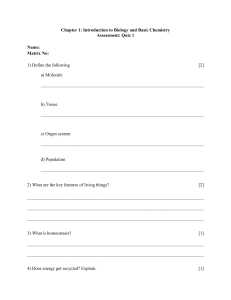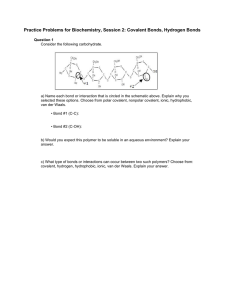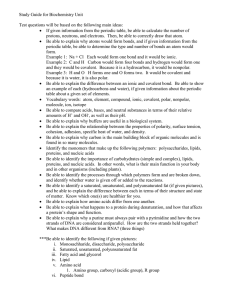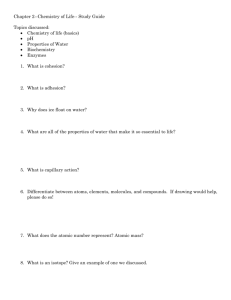Biology Chapter 2 Outline
advertisement
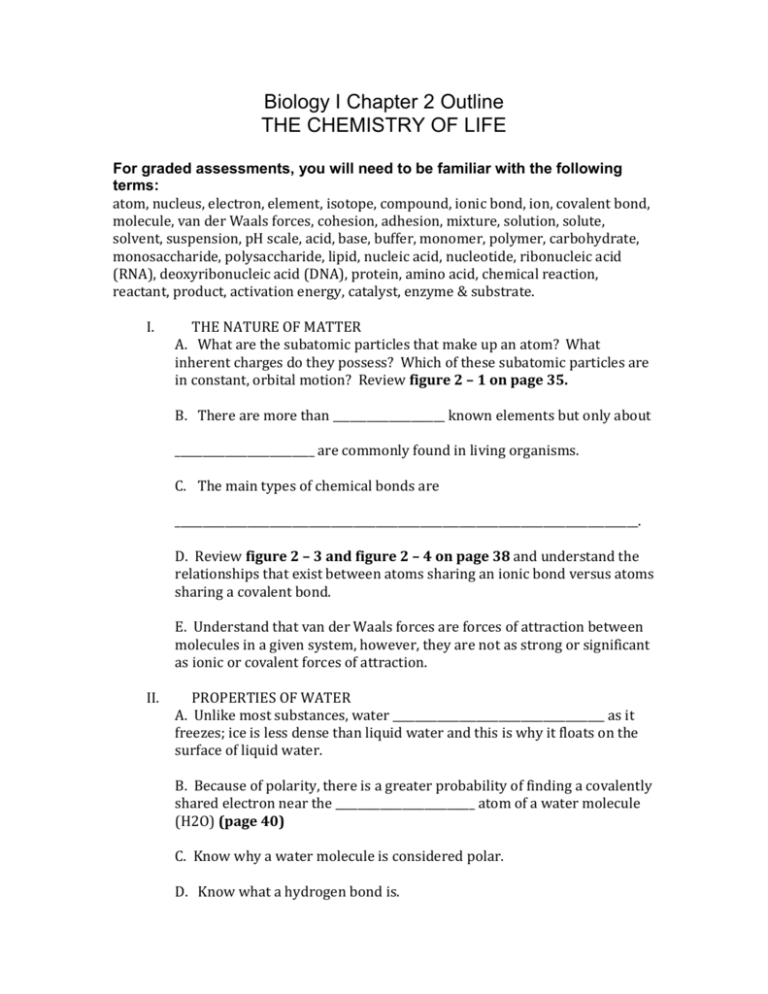
Biology I Chapter 2 Outline THE CHEMISTRY OF LIFE For graded assessments, you will need to be familiar with the following terms: atom, nucleus, electron, element, isotope, compound, ionic bond, ion, covalent bond, molecule, van der Waals forces, cohesion, adhesion, mixture, solution, solute, solvent, suspension, pH scale, acid, base, buffer, monomer, polymer, carbohydrate, monosaccharide, polysaccharide, lipid, nucleic acid, nucleotide, ribonucleic acid (RNA), deoxyribonucleic acid (DNA), protein, amino acid, chemical reaction, reactant, product, activation energy, catalyst, enzyme & substrate. I. THE NATURE OF MATTER A. What are the subatomic particles that make up an atom? What inherent charges do they possess? Which of these subatomic particles are in constant, orbital motion? Review figure 2 – 1 on page 35. B. There are more than ____________________ known elements but only about _________________________ are commonly found in living organisms. C. The main types of chemical bonds are ___________________________________________________________________________________. D. Review figure 2 – 3 and figure 2 – 4 on page 38 and understand the relationships that exist between atoms sharing an ionic bond versus atoms sharing a covalent bond. E. Understand that van der Waals forces are forces of attraction between molecules in a given system, however, they are not as strong or significant as ionic or covalent forces of attraction. II. PROPERTIES OF WATER A. Unlike most substances, water ______________________________________ as it freezes; ice is less dense than liquid water and this is why it floats on the surface of liquid water. B. Because of polarity, there is a greater probability of finding a covalently shared electron near the _________________________ atom of a water molecule (H2O) (page 40) C. Know why a water molecule is considered polar. D. Know what a hydrogen bond is. E. What is capillary action? (page 41) F. Look at figure 2 – 8 and consider the concept of surface tension as it relates to cohesion – a property of liquid water. G. Know the difference between acids and bases. Acids dissociate and liberate hydrogen ions/protons and bases take up hydrogen ions/protons in solution. (page 43) III. CARBON COMPOUNDS A. Macromolecules are formed by a process known as ________________________________________. B. Be able to list the four groups of organic compounds found in living things. (page 45) C. Carbohydrates are used as a ______________________________________________________, and by plants and some animals for _________________________________________________________________. D. Distinguish between monosaccharides and polysaccharides. E. Review figure 2 – 14 on page 46 to understand the chemical structure of a lipid. Lipids are used by biological systems to ______________________________________, to constitute _________________________________________________ and to impart __________________________________ coverings. F. If there is at least one carbon-carbon double bond in a fatty acid, the fatty acid is said to be _________________________________________. G. What are the functions of nucleic acids? H. List the functions of proteins given on page 48 in bold. IV. CHEMICAL REACTIONS AND ENZYMES A. Chemistry is not just what life is made of…it is also what life __________________. B. Chemical reactions always involve changes in the chemical bonds that _______________________________________________________________________________. C. Understand that energy is released when chemical bonds are broken and energy is absorbed when chemical bonds are formed. D. Chemical reactions that release energy occur ____________________________________; reactions that absorb energy will not occur without an ______________________________________________. (page 50) E. Enzymes speed up chemical reactions that take place inside ________________________. Review figure 2-20 on page 51 and understand activation energy. F. Review pages 52 – 53 and understand the general mechanism of an enzyme, a substrate and a final product of this facilitated reaction. What factors are important for these types of biochemical processes to occur?
